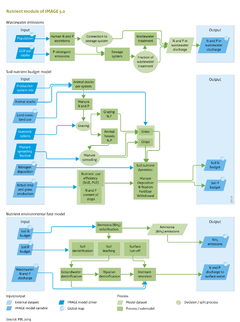Nutrients/Data uncertainties limitations: Difference between revisions
Jump to navigation
Jump to search
m (Text replace - "|Status=On hold" to "") |
No edit summary |
||
| Line 1: | Line 1: | ||
{{ComponentDataUncertaintyAndLimitationsTemplate | {{ComponentDataUncertaintyAndLimitationsTemplate | ||
|Reference=Bouwman et al., 2009; OECD, 2012; FAO, 2012; Beusen et al., 2008; | |Reference=Bouwman et al., 2009; OECD, 2012; FAO, 2012; Beusen et al., 2008; | ||
|Description=<h2>Data, uncertainties and limitations</h2> | |Description=<h2>Data, uncertainties and limitations</h2> | ||
The data | ===Data=== | ||
The data stem from various parts of IMAGE, such as land cover, biomes, crop production and allocation, livestock, fertiliser use and nutrient excretion rates. Environmental data include temperature and precipitation, runoff, and soil properties. | |||
External data are used for determining historical N excretion rates, manure spreading and fertiliser use efficiency, and their development in the future is a scenario assumption. Additional information used only in this chapter includes lithology, relief and slope of the terrain. Additional data used in the nutrient budget model include subnational data as used for the United States and China. | |||
===Uncertainties=== | |||
With regard to uncertainties, the budget calculations and individual input terms for 2000 have been found to be in close agreement ([[Bouwman et al., 2009]]) with detailed country estimates for the member countries of the Organisation for Economic Co-operation and Development ([[OECD]]) ([[OECD, 2012]]). | |||
However, uncertainty is larger for some of the budget terms than for others. Data on fertiliser use are more reliable than on N and P animal excretions, which are calculated from livestock data ([[FAO, 2012]]) and excretion rates per animal category. Data on crop nutrient withdrawal are less certain than on crop production, because the withdrawal is calculated with fixed global nutrient contents of the harvested proportions of marketed crops. In addition to uncertainty in nutrient contents, major uncertainties arise from insufficient data, for instance, on crops that are not marketed and on the use of crop residues. This leads to major uncertainties about nutrient withdrawal. | |||
Sensitivity analysis ([[Beusen et al., 2008]]) has shown that the main determinants of the uncertainty in the nutrient model are: | |||
#N excretion rates; | |||
#NH3 emission rates from manure in animal housing and storage systems; | |||
#the proportion of time that ruminants graze, the proportion of non-agricultural use of manure in mixed and industrial systems; | |||
#animal stocks. | |||
}} | }} | ||
Revision as of 11:36, 12 February 2014
Parts of Nutrients/Data uncertainties limitations
| Component is implemented in: |
| Components: |
| Related IMAGE components |
| Projects/Applications |
| Key publications |
| References |
